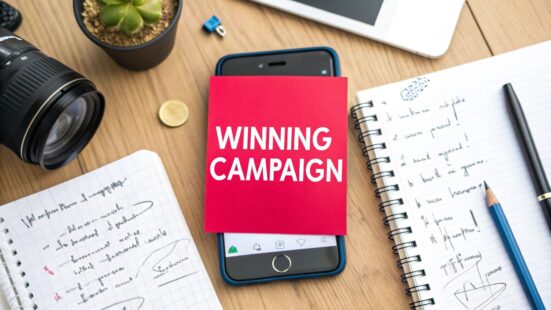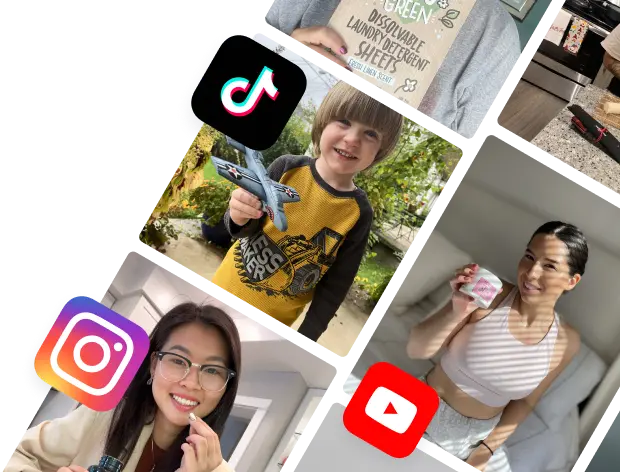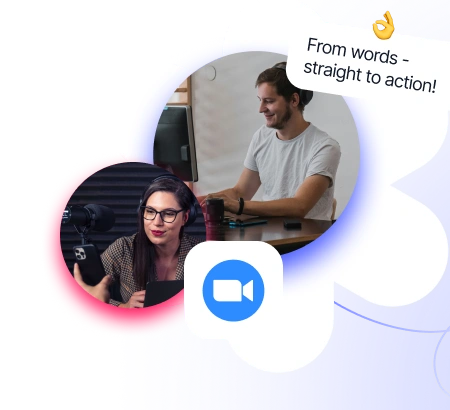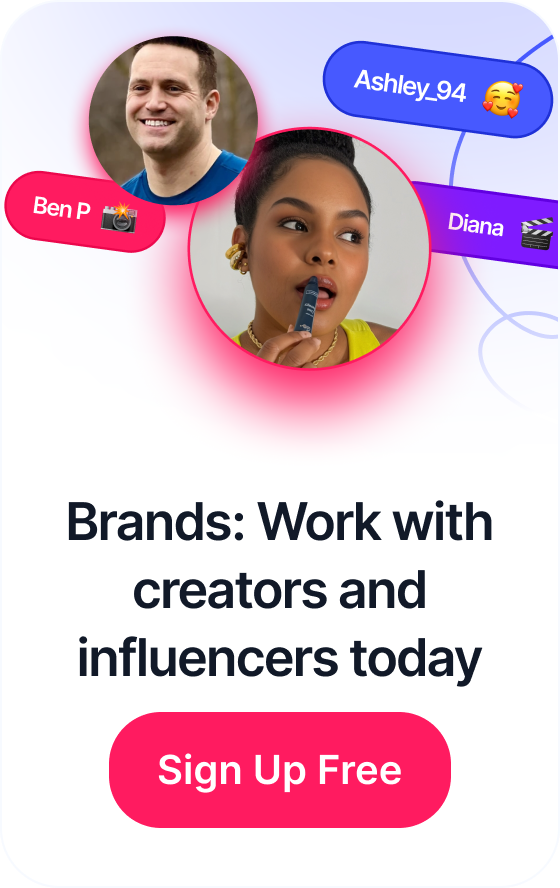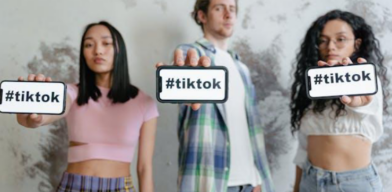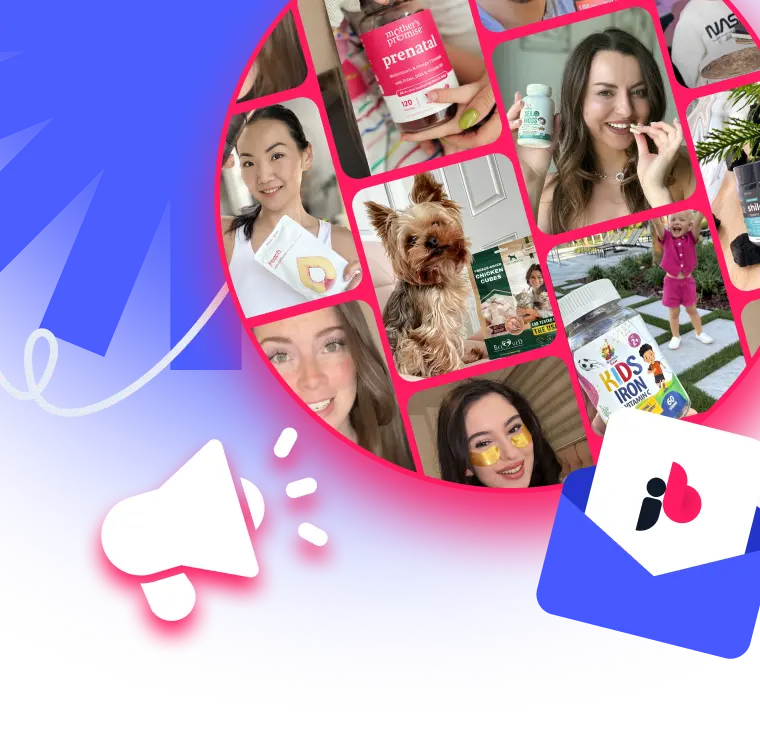 7 YouTube Shorts Best Practices for Viral Growth in 2025
7 YouTube Shorts Best Practices for Viral Growth in 2025
An influencer marketing campaign is way more than just paying a creator to post about your stuff. Think of it as a strategic partnership. You're tapping into a creator's trusted voice to build a real, authentic connection with an audience that's already listening. It’s about being part of the conversation, not just interrupting it with an ad.
Table of Contents
Building the Foundation for Your Campaign
Before you even think about sliding into a single DM, you need a rock-solid plan. This is where the magic really happens. The most successful campaigns are built on a strategic foundation that turns a fuzzy idea into a concrete, actionable roadmap.
Skipping this part is like trying to build a house without a blueprint. Sure, you might get a wall or two up, but it's going to be messy, inefficient, and probably fall over. The initial planning steps are all about connecting the dots, as you can see below.
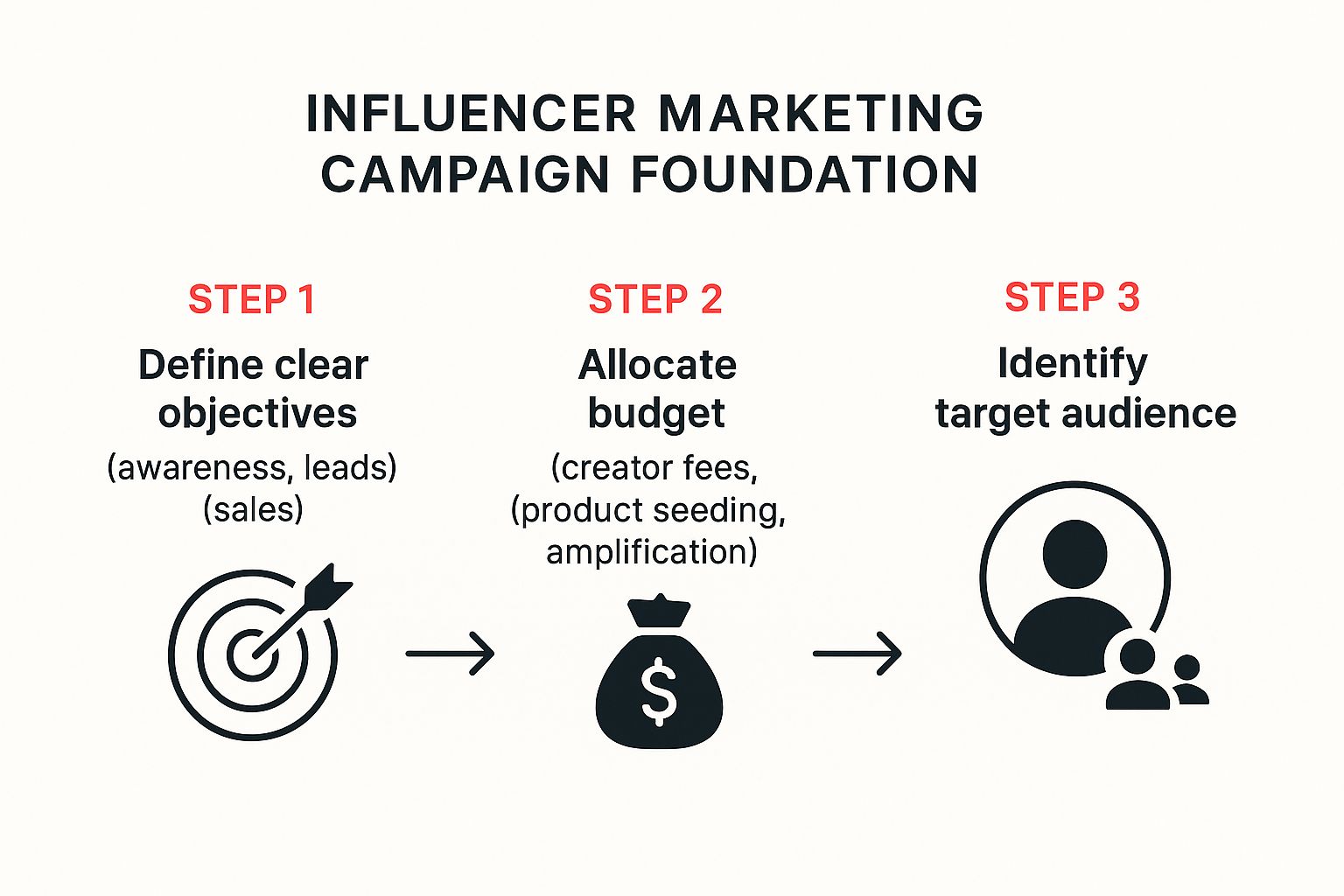
This process shows how everything is linked: your goals dictate your budget, and your budget helps define the audience you can realistically reach.
Set Clear and Meaningful Objectives
First things first: what are you actually trying to achieve? And no, "get more likes" or "go viral" don't count. We're talking about tangible business outcomes you can actually measure.
Every single decision you make—from which creators you pick to the type of content you ask for—needs to tie back to these goals. Your objectives will typically fall into one of three buckets:
- Awareness: This is all about getting your brand or a new product in front of more eyeballs. You'll be looking at metrics like reach, impressions, and video views to see if you're hitting the mark.
- Consideration: Here, the goal is to spark interest and get people to take that next step. Success looks like link clicks, landing page visits, or a bump in your own social media followers.
- Conversion: This is the bottom line. You want to drive sales, sign-ups, or leads. Your main metrics will be conversion rates, sales tracked through unique discount codes, and, of course, the overall return on investment (ROI).
To help nail this down, I've put together a quick reference table.
Campaign Objective and Key Performance Indicator (KPI) Alignment
This table connects your main campaign goals with the right metrics to track, making it easier to measure what truly matters.
| Campaign Objective | Primary KPI | Secondary KPI | Example Metric |
|---|---|---|---|
| Awareness | Reach/Impressions | Video Views | 500,000 unique accounts reached |
| Consideration | Link Clicks | Engagement Rate (Likes, Comments) | 5% Click-Through Rate (CTR) |
| Conversion | Sales/Leads | Return on Investment (ROI) | 150 sales via influencer code |
Getting this alignment right from the start is non-negotiable for a successful campaign.
A great way to get your wheels turning is to see how other brands have done it. Checking out a few influencer marketing campaign examples can show you how a clear objective translates into a killer creative strategy and measurable results.
Create a Realistic Financial Plan
Once your goals are locked in, it's time to talk money. A common mistake is thinking the budget is just for paying influencers. That's a fast track to unexpected costs and headaches. A proper financial plan covers all the bases.
Here’s what you need to account for:
- Creator Compensation: This will be your biggest line item. It could be a flat fee, a commission deal, or some hybrid of the two.
- Product Seeding: Don't forget the cost of the actual products you're sending out, plus shipping. It adds up.
- Content Amplification: Got a post that’s killing it? Put some money behind it. Boosting high-performing influencer content as a paid ad can massively expand its reach.
- Platform or Agency Fees: If you're using software or working with an agency to manage the campaign, their fees need to be factored in.
Brands are pouring money into this space for a reason—it works. The influencer marketing industry's value is expected to rocket from around $10 billion in 2020 to $32.55 billion in 2025. This isn't just a trend; it's a fundamental shift in how brands connect with people. You can dig into more of that growth data over at Statista.com.
A well-planned budget isn’t a limitation; it's a strategic tool. It forces you to prioritize objectives and make smarter decisions about where to invest for the highest potential return.
Define Your Target Audience Persona
Finally, you have to know exactly who you're talking to. A vague idea of your customer isn't enough. You need a detailed audience profile to make sure you're working with the right creators who can reach the right people.
Go beyond the basic demographics like age and location. Dig into the psychographics:
- What are their passions and hobbies?
- Which social media platforms are they obsessed with?
- What kind of content do they save, share, and comment on?
- Who do they already follow and trust for recommendations?
When you can answer these questions, you can find creators whose followers are a mirror image of your ideal customer. That perfect alignment is the secret sauce for a campaign that doesn't just get seen but actually resonates and drives action.
Finding and Vetting the Right Creators
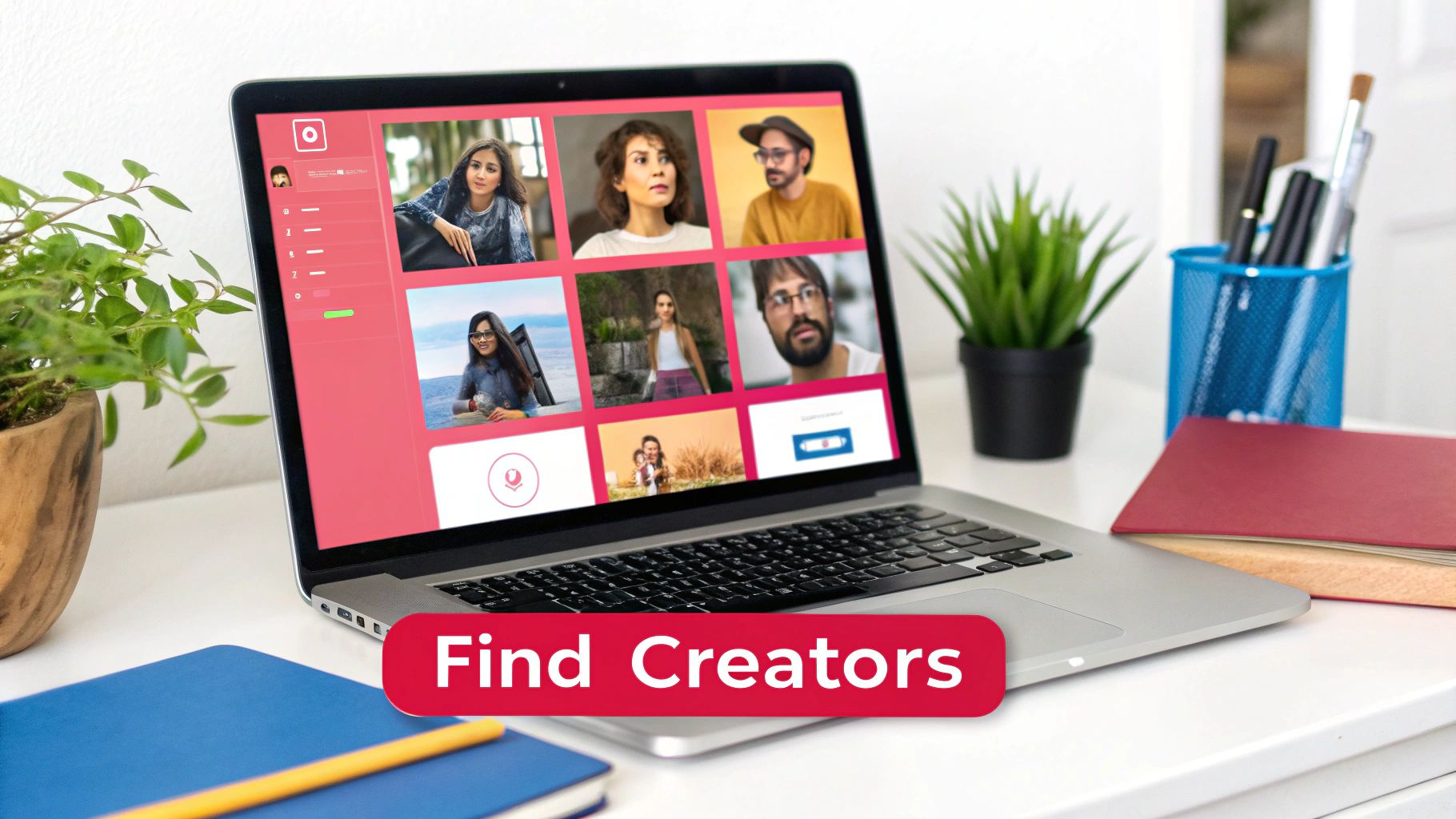
Let's be honest: your entire campaign lives or dies by the creators you choose. This is the single most critical decision you'll make. Picking influencers who are a genuine, natural fit for your brand is the difference between a campaign that truly connects and one that just feels… off.
Think about it. You wouldn't hire a hardcore gamer to promote a luxury skincare line. The same logic applies here. The magic happens when a partnership feels so authentic that it doesn’t even seem like an ad. That’s how you build trust and get your message across.
Understanding the Creator Tiers
Bigger isn't always better. In fact, sometimes the opposite is true. The influencer world is broken down into tiers, and each one offers a completely different strategic advantage. Knowing the landscape helps you put your money where it will work hardest.
- Nano-Influencers (1K-10K followers): These are your hyper-niche, super-relatable creators. They often boast the highest engagement rates because they have a tight-knit community that hangs on their every word. Perfect for building grassroots trust.
- Micro-Influencers (10K-100K followers): This is the sweet spot for many brands. Micro-influencers balance solid reach with fantastic engagement, making them cost-effective powerhouses. Their followers see them as trusted experts.
- Macro-Influencers (100K-1M followers): When you need to drive serious brand awareness, you turn to macro-influencers. They're established names who can get your brand in front of a much broader audience while still holding onto some niche credibility.
- Mega-Influencers (1M+ followers): Think celebrities and household names of the digital world. The reach is massive, no question. But it comes with a hefty price tag and, often, lower engagement rates compared to the smaller guys.
There's a reason so many seasoned marketers are leaning into smaller creators. Recent research shows a huge preference for working with nano (44%) and micro (26%) influencers over their pricier counterparts.
Mastering the Art of Discovery
So, where do you actually find these people? Don’t just stick to one method. The best approach is a mix of high-tech tools and good old-fashioned digital detective work. This is how you uncover the real gems.
Influencer discovery platforms are a fantastic starting point. Tools like these let you slice and dice the creator universe by niche, audience demographics, location, engagement rates—you name it. They can save you dozens of hours and give you the hard data to back up your choices.
But don't stop there. Get your hands dirty and do some manual searching right on the platforms where your audience lives.
- Go Down the Hashtag Rabbit Hole: Search for hashtags relevant to your industry. Who is consistently creating killer content and sparking real conversations?
- Spy on Your Competitors: Check out who your competitors are partnering with. Even more telling, dig into the comments on their sponsored posts to see which other creators their audience loves and interacts with.
- Dig Into Your Own Audience: Who are your brand's most engaged followers listening to? Explore their profiles and see who they follow. You might find creators who are already a perfect fit hiding in plain sight.
This hands-on approach is often how you find incredible, up-and-coming creators before they get swamped with brand deals.
Key Takeaway: The best creator for your brand isn't always the one with the most followers. It's the one whose audience is your target customer and whose content style genuinely mirrors your brand's values.
The Comprehensive Vetting Checklist
Got a shortlist? Great. Now comes the most important part: vetting. This isn't just about avoiding a PR headache; it's about protecting your brand's reputation. You have to look past the vanity metrics and really dig deep.
Here’s a checklist to run every potential creator through. No exceptions.
Audience Demographics: Does their audience match your target customer? Ask for their media kit or screenshots of their audience analytics showing age, location, gender, and interests. If there's a major mismatch, it’s an immediate no.
Real Engagement Rate: Forget likes. Calculate their true engagement rate: ((likes + comments) / followers) x 100). For a micro-influencer, a healthy rate is around 1-3%. But also look at the quality of the comments. Are people having actual conversations, or is it just a wall of fire emojis and bot spam?
Content and Vibe Check: Scroll through their last 20-30 posts. Is the quality high? Is their style creative and consistent with your brand's look and feel? If you're a wellness brand, a creator whose feed is full of late-night party content is just not going to work.
Brand Safety Scan: Do a deep dive into their past. Look for any controversial posts, questionable associations, or signs of inauthentic behavior like buying followers. When you partner with them, their reputation becomes yours.
Sponsorship History: How many sponsored posts do they do? If they're promoting a different brand every other day, their audience likely has sponsorship fatigue. Your message will get lost in the noise. Look for creators who are selective and authentic in their partnerships.
Sticking to a tough vetting process like this is how you lock in partnerships with creators who are credible, authentic, and ready to drive real results for your campaign.
Crafting Outreach That Gets a Response
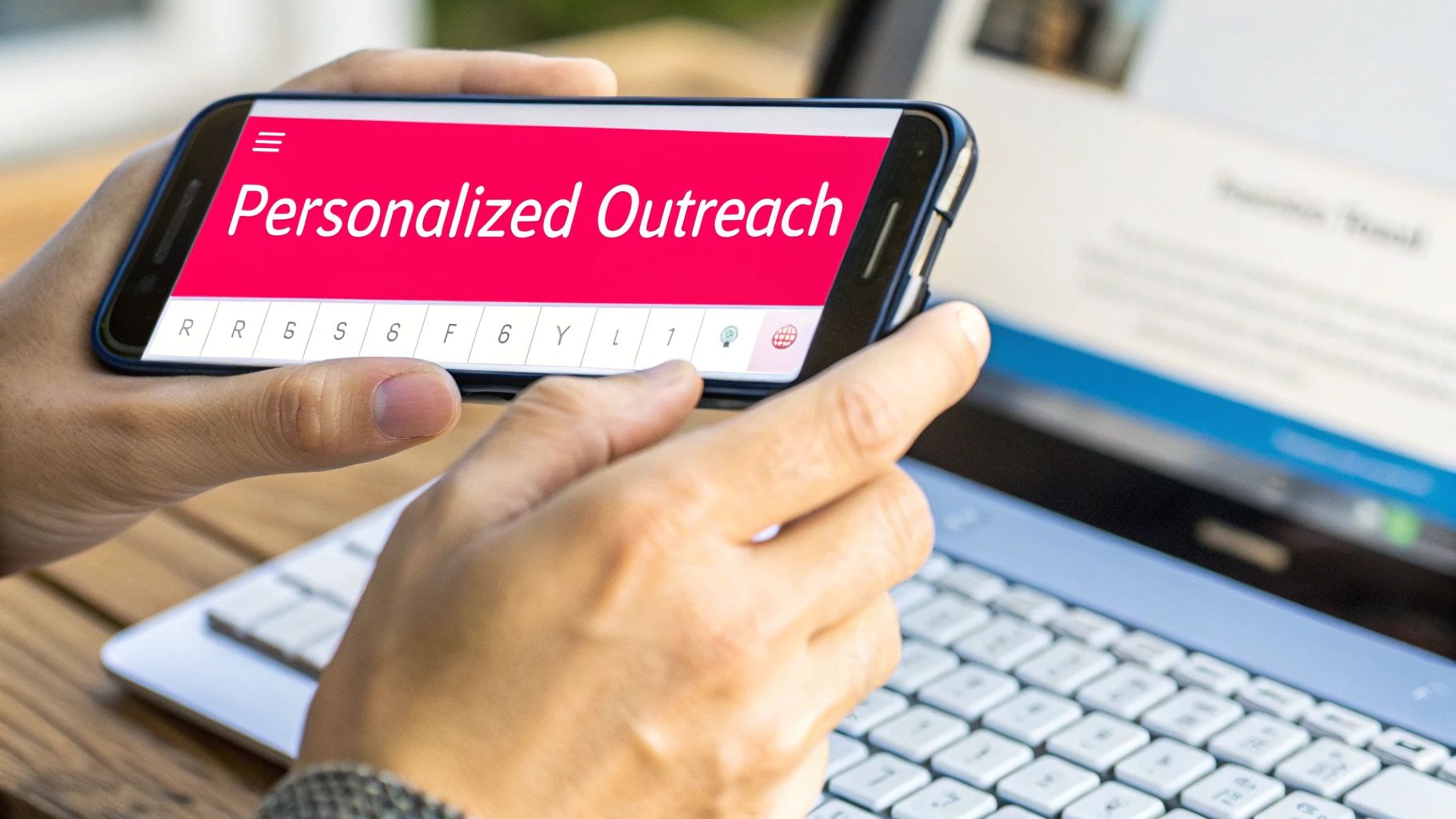
Let's be real: a top creator's inbox is a battlefield. They get slammed every single day with generic, low-effort requests. If you want to cut through that noise, your outreach has to be sharp, personalized, and genuinely compelling.
A copy-and-paste template is a one-way ticket to their trash folder.
The goal of your first message isn’t to close the deal. It’s simply to start a conversation. You have to show them you’ve actually done your homework and see them as a real partner, not just a walking billboard. Nailing how to write cold emails that get replies is the skill that separates the pros from the amateurs in this game.
Personalizing Your Initial Pitch
Before you even think about typing a single word, dive into their content. What makes them tick? What's their unique angle? Reference a specific video, a recent post, or even a comment they made that you genuinely connected with. This tiny bit of effort immediately shows you're not just another brand blasting out mass emails.
Your first pitch needs to be concise and value-packed. Get straight to the point: who you are, what you love about their work, and why you think a partnership would be a fantastic fit for their audience. Keep it brief. Respect their time.
Here’s a quick checklist for that first email:
- A personal connection: Mention something specific you enjoyed about their content. "Your recent video on cold brew techniques was a game-changer for my morning routine!"
- A clear brand intro: Briefly explain what your brand does and who it's for.
- The "why": Connect the dots for them. Why would your product actually make sense for the community they've built?
- An open-ended question: End with a soft call to action. Something like, "Would you be open to hearing more?" works way better than a hard sell.
Navigating Negotiations with Confidence
Once you get that exciting "yes," the negotiation phase begins. Don't let this part intimidate you; it’s a standard piece of the puzzle. This is where all that initial planning on your budget and desired outcomes really pays off.
The compensation model you land on will depend on your goals and what the creator is comfortable with. Be ready to talk through a few common options:
- Flat Fee: A one-time payment for specific deliverables. This is the most common and straightforward model.
- Product Gifting (Product Exchange): A great option for smaller creators or for getting initial product reviews.
- Affiliate Commission: The creator earns a percentage of sales from their unique link or code. This performance-based model can be a huge win-win.
Interestingly, the market is getting more efficient. The average Cost Per Mille (CPM) in influencer marketing actually dropped by 53% year-over-year in 2025. And while 57% of creators upped their rates, a surprising 83% are still open to working in exchange for products they genuinely love. It shows a healthy mix of passion and business.
Pro Tip: Always start the conversation by asking for the creator's media kit and standard rates. It shows you respect them as a business and sets a professional tone right from the start.
Locking It Down with a Clear Contract
I can't stress this enough: never, ever work with an influencer without a signed contract. This document protects both of you. It lays out all the expectations clearly and prevents those awkward "I thought you meant…" conversations down the line.
It doesn't need to be a 50-page legal document written by a team of lawyers, but it absolutely must cover the essentials. Think of it as your single source of truth for the entire collaboration.
Essential Contract Clauses:
- Content Deliverables: Get specific. How many posts, stories, or videos? On which platforms?
- Usage Rights: Define how and where you can repurpose their content. Can you use it on your website? In paid ads? For how long?
- Exclusivity: Does this agreement prevent the influencer from working with your direct competitors for a certain amount of time?
- FTC Disclosure: This is non-negotiable. The contract must require the creator to follow all advertising guidelines, like using #ad or the "Paid Partnership" label. This is your legal responsibility, too.
- Payment Terms: Detail the total compensation, the payment schedule (e.g., 50% upfront, 50% on completion), and how they’ll be paid.
Managing Creator Relationships And Content

You’ve signed the agreements, and now it’s showtime. This is where ideas turn into scroll-stopping posts. Your role? Guide the process, hand over the tools, then let your creators do what they do best.
Think less boss, more director. Set the scene, share your vision, then give the talent the space to improvise. That balance is the secret sauce behind content that feels genuine and drives the results you want.
Develop A Clear Yet Flexible Creative Brief
A creative brief should light the path, not build walls. It’s your single source of truth—concise, actionable, and open enough to let each creator’s voice come through.
Here’s what to include:
- Campaign Goals: Reiterate your main objective, whether it’s driving site visits or boosting app installs.
- Key Messaging: Highlight the top 2–3 points their audience absolutely must remember.
- Mandatory Elements: Specify required hashtags, tags, or calls-to-action.
- The “Don’ts”: Outline brand safety rules and off-limits topics.
With these guardrails in place, creators can shape your message into something that feels like them—and that’s exactly why their followers trust every word.
Master The Content Approval Process
Review can either build momentum or stall progress. Your aim is swift, pointed feedback—no marathon editing sessions.
Start by setting clear timelines. Let creators know you’ll circle back in 24–48 hours and who’s the point person. When you comment, focus on details:
- Swap “I don’t like this” for “Can we see the product in softer, natural light?”
- Trade “This isn’t right” for “Let’s highlight that texture closer up.”
“You brought them on board for their creative instinct. Respect it. Over-polishing content until it feels corporate strips away its authenticity.”
Effective influencer relationship management hinges on timely, respectful communication.
Nurture Long-Term Brand Ambassadorships
A campaign shouldn’t be a one-and-done effort. The real magic happens when you turn great collaborators into ongoing partners.
Here’s how to cultivate loyalty:
- Invite creators to behind-the-scenes brand events.
- Give them early access to new products.
- Showcase their work on your own channels (with permission).
Those extra touches tell creators you see them as more than a vendor. They’ll reward that respect with content that resonates deeper. For a boost, check out these strategies to boost social media engagement—they’ll help you keep the conversation alive long after a post goes live.
How to Measure Your Campaign ROI
The content is live, the comments are rolling in, and your campaign is in full swing. But let’s get to the most important question: did it actually work?
Figuring this out is the final, most critical piece of the puzzle. It’s how you prove your campaign’s value, justify the budget, and get smarter for the next round.
Measuring success isn't about chasing vanity metrics like likes and views. Real analysis means connecting the dots directly back to the goals you set in the very beginning. If you were aiming for sales, you need to track sales. If it was all about lead generation, you need to count the leads. Anything less is just guesswork.
Going Beyond Surface-Level Metrics
To get a clear picture of your return on investment, you need the right tools in your arsenal. Simple, trackable links are the foundation here—they cut through the noise and directly attribute actions to specific creators, giving you undeniable proof of what’s driving results.
Here are the must-have tracking methods for any serious campaign:
- UTM Parameters: These are small snippets of code you add to the end of a URL. They let you see exactly where your website traffic is coming from inside analytics platforms like Google Analytics. You can create unique UTMs for each influencer to track clicks, session duration, and conversions with laser precision.
- Custom Discount Codes: This is one of the easiest and most effective ways to track direct sales. Just assign a unique code to each creator (e.g., "JANE15"). When a customer uses that code at checkout, you know exactly who drove that sale. It’s simple and powerful.
- Affiliate Links: Similar to UTMs, these are unique, trackable links you give to influencers. They often work on a commission basis, where the creator earns a percentage of each sale they generate through their link.
These tools provide the hard, quantitative data you need. They tell you what happened. But to understand why it happened, you need to dig a little deeper.
Tracking Methods for Influencer Campaign ROI
Choosing the right method really depends on your specific goals. This table breaks down the most common approaches to help you decide which one fits your campaign best.
Tracking Methods for Influencer Campaign ROI
| Tracking Method | How It Works | Best For | Pros | Cons |
|---|---|---|---|---|
| UTM Parameters | Adds unique tags to URLs to track traffic sources in Google Analytics. | Driving Website Traffic & Leads | Highly detailed data on user behavior. | Can look complex; doesn't directly track offline sales. |
| Custom Discount Codes | Assigns a unique code to each influencer for customers to use at checkout. | E-commerce Sales & Conversions | Easy for both customers and brands to use and track. | Only captures sales; misses awareness and traffic data. |
| Affiliate Links | Provides a unique, cookie-based link that tracks clicks and subsequent sales. | Performance-Based Sales Campaigns | Pay-for-performance model minimizes upfront risk. | Requires an affiliate platform; may feel less authentic. |
Getting a handle on these options is key. Our guide on how to measure influencer marketing ROI provides an even deeper dive into these methods and the specific formulas you can use to calculate your return.
Blending Quantitative Data with Qualitative Insights
Numbers tell a powerful story, but they don't tell the whole story. To get a complete picture of your campaign's impact, you have to look at the qualitative feedback, too. This is the human element—the conversations, the sentiment, and the way people perceive your brand.
Dive into the comment sections of your influencer's posts. What are people saying? Are they asking questions about the product's features? Tagging their friends? This is pure gold, direct feedback from your target audience.
A single, thoughtful comment like, "I've been looking for something exactly like this! Just ordered," is often more telling than a hundred likes. It signals genuine interest and purchase intent.
This kind of feedback helps you understand audience sentiment and can spark amazing ideas for future marketing angles or even product improvements.
Transforming Data into Actionable Insights
The final step is to bring all this information together. Compare your performance metrics against the KPIs you set way back at the start. Did you hit your sales target? Did you reach your desired number of impressions?
Don’t just file the report and move on. Use these insights to make your next influencer campaign even better.
Maybe you discovered that video content on TikTok drove twice as many conversions as static posts on Instagram. That’s a powerful insight you can use to adjust your strategy and budget for the future.
This continuous loop of planning, executing, measuring, and optimizing is what separates good campaigns from great ones. It's also why over 80% of marketers consider influencer marketing a highly effective strategy for driving real business results. As brands continue to see strong returns, it's no surprise that 63.8% plan to partner with influencers in 2025, solidifying its place as a core marketing channel. You can discover more insights about influencer marketing trends to see how the industry is evolving.
Still Have Questions About Influencer Marketing?
Even with the best game plan, stepping into the world of influencer marketing can feel a little like you're exploring new territory. You've got the map, but you're bound to have some questions pop up as you go.
Let's clear the air on some of the most common things brands ask. Think of this as your friendly guide to navigating those final uncertainties before you dive in.
How Much Does An Influencer Marketing Campaign Cost, Really?
This is the big one, isn't it? The honest-to-goodness answer is: it's completely up to you and your strategy. There's no magic number. You could spend a few hundred dollars on a single post from a micro-influencer or invest tens of thousands into a massive campaign with a top-tier creator.
Instead of trying to find a standard price, flip the script. Start with your total budget, then work backward. Do you want to go all-in on one major creator for massive reach? Or would that same budget be better spent on a small army of niche creators who have a super-dedicated following? It's a strategic call.
And don't forget the "hidden" costs. Your budget needs to account for more than just the influencer's fee.
- Product Seeding: The cost of the actual products you're sending out, plus any shipping.
- Content Amplification: Got a post that's performing like a rockstar? You'll want some cash set aside to put paid ad spend behind it.
- Platform or Agency Fees: If you're using software or hiring help, that needs to be factored in.
There's a reason the industry is projected to hit around $24 billion in 2024—brands are seeing real, tangible returns.
What Metrics Actually Matter?
The metrics you track should be a direct mirror of the goals you set from day one. A huge mistake I see brands make is chasing vanity metrics that have nothing to do with their actual objectives.
If your goal is brand awareness, you should be obsessed with numbers like:
- Reach (how many unique eyeballs saw the content)
- Impressions (how many times the content was seen in total)
- Engagement Rate (the magic formula of likes, comments, shares, and saves vs. follower count)
But if you're all about driving sales, the story changes. Your focus shifts to the bottom line.
- Conversion Rate (what percentage of clicks turned into a purchase?)
- Cost Per Acquisition (CPA)
- Return on Investment (ROI)
The easiest way to track this? Give each influencer a unique discount code or an affiliate link. It’s the cleanest, most direct way to see exactly who is driving sales. No guesswork involved.
How Do I Make Sure Influencers Disclose Properly?
This one is non-negotiable, and the buck stops with you, the brand. Following advertising rules, like the FTC guidelines, isn't a suggestion—it's a requirement. Your contract with the influencer must clearly spell out that they need to disclose the paid partnership.
On Instagram, that means using the official "Paid Partnership" label. They also need to include a crystal-clear hashtag like #ad or #sponsored right at the top of their caption. Don't let them bury it in a sea of other hashtags at the bottom.
It's not enough to just have it in the contract. You need to actively educate your partners on the rules and double-check their posts to make sure they're compliant. Getting this wrong can lead to serious penalties and damage the trust you have with your audience.
Should I Run This In-House or Hire an Agency?
The classic "DIY vs. hire a pro" debate. Your decision here really hinges on your team's bandwidth, their experience, and the size of your campaign.
Going the in-house route is perfect for smaller campaigns or if you have a team member who lives and breathes this stuff. You get total control, build direct relationships with creators, and it can definitely be lighter on the wallet.
On the flip side, bringing in an influencer marketing agency is often the smart move for bigger, more intricate campaigns. They come with a ton of advantages. Agencies have ready-made relationships with creators, they're sharks when it comes to negotiation, and they have access to powerful software you might not.
An agency takes care of the nitty-gritty—finding influencers, vetting them, handling contracts, and pulling all the reports. This lets your team stay focused on the big-picture strategy.
Ready to connect with a vast network of vetted creators and streamline your next campaign? JoinBrands offers the tools you need to discover the perfect partners, manage collaborations, and track your ROI all in one place. Start your next influencer marketing campaign with JoinBrands today!
